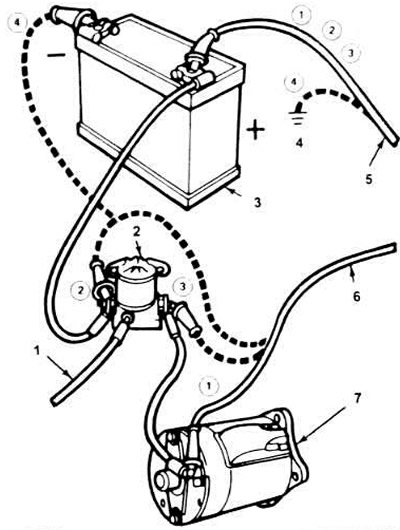Note: Before diagnosing the starter, make sure the battery is fully charged.
General check
1. If the starter motor does not turn at all when the ignition is on, check if the speed selector lever is at "neutral" or "parking lot" (for automatic transmission), whether the clutch pedal is depressed (Manual Transmission).
2 Make sure that the battery is charged and that all the wires at the battery terminals and the starter relay are in order.
3 If the starter motor rotates, but the car engine does not turn, then the starter is defective and will need to be replaced (see section 19).
4. If the starter motor does not work when the key is turned while the relay is working (clicks are heard), which means that the matter is either in the battery, to which the relay contacts are connected, or in the contacts of the starter motor itself.
5. If the clicks are not heard when the ignition key is turned, then either the starter relay circuit is open, or the relay itself is faulty.
Check starter relay circuit (see wiring diagrams at the end of the book), or replace the relay (see section 20).
6. To test the starter relay circuit, remove the plug from the relay wire (red with blue stripe). Make sure the wire connections are clean and tight and the relay bracket is engaged.
If everything is in order with the contacts, check the operation of the relay using the connecting wire. To do this, set the gearbox to "parking" (automatic), and mechanical to neutral. Remove the removable tip from the relay. Connect one end of the connecting wire to the positive contact of the battery, and the other to the relay contact. If the starter now works, then" the relay is ok. It's all about the ignition key, the neutral position sensor, or the wires in the ignition circuit.
7. If the starter motor does not work, replace the starter relay (see section 20).
8. If the starter motor turns the engine at too low speed, first of all make sure that the battery is fully charged, all the contacts are clean and connected tightly, also check the contacts of the starter relay and battery ground. The contact lugs must not be pulled out freely by hand.
Check if there is a short circuit "mass". The engine will rotate slowly if it is filled with oil of the wrong viscosity or if it partially seizes.
Checking the starter rotation circuit
Note: To locate a high resistance in the starter circuit, perform the following series of simple tests.
9. Disconnect the ignition coil wire from the distributor cap and ground it to the engine.
10. Connect the starter control switch to contact S of the relay and disconnect from the contact of the relay going to the battery.
11. Connect the positive wire of the voltmeter to the contact of the starter motor that is connected to the relay, then ground the negative wire.
12. For testing, connect the wires as shown. They will help you complete the 4 tests described below.

18.12. Four points for connecting contacts when testing the starter circuit.
1. To the ignition key.
2. Relay.
3. Battery.
4. Grounding to the motor.
5. Positive contact of the voltmeter.
6. Negative contact of the voltmeter.
7. Starter.
The circled numbers indicate the position of the wires during each of the four tests.
13. Working with the ignition key, take readings from the voltmeter as soon as a certain value is set. One-time operation of the starter should not exceed 30 seconds.
14. The voltmeter will record the voltage drop in the circuit (set the voltmeter measurement range from 0 to 2 volts). The maximum allowable voltage drops must be:
A) 0.5 volts with the negative wire of the voltmeter connected to the starter terminal, and the positive wire to the positive terminal of the battery (connection 1 in fig. 18.12).
b) 0.1 volts with negative voltmeter wire connected to starter relay (battery side), and positive - to the positive contact of the battery (compound 2).
V) 0.3 volts when negative voltmeter lead connected to starter relay (from the starter side), and positive - to "plus" battery (connection 3).
G) 0.3 volts when the negative lead of the voltmeter is connected to negative" batteries battery positive "grounded" on the engine (compound 4).
Visitor comments